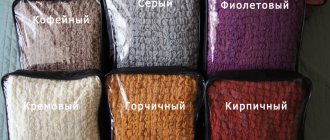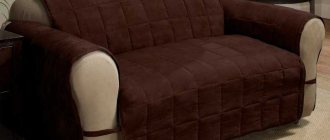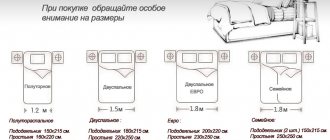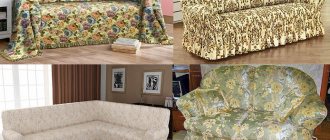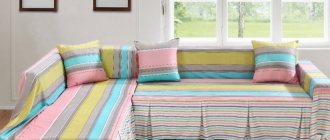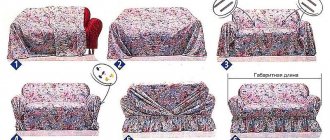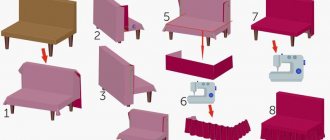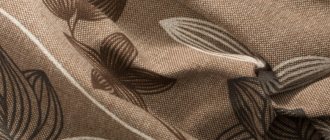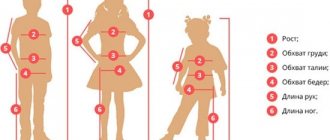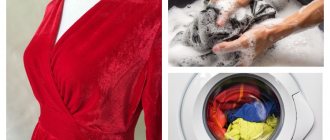For many people, a sofa is an important piece of furniture, with significant value and high quality. Often, models are purchased that are so expensive that it is impractical to leave them unprotected. This is especially true if small children or pets live in the house. Therefore, a Euro-cover for a sofa is purchased, which provides excellent protection of products from various factors, they have an attractive appearance, and often act as a decoration for old furniture. If desired, you can create your own cover, since it is not difficult to create it with your own hands; for this it is only important to understand the correct technology that answers the question of how to sew the product.
Advantages and disadvantages
Before purchasing or creating a Euro-case yourself, you should understand what positive and negative parameters its use has. The main advantages include:
- versatility, allowing the product to be used on a 3-seater sofa or on a corner sofa with a protrusion on the left, as well as on other forms of this furniture;
- the sofa cover is created from a unique elastic fabric that is resistant to dirt or various mechanical influences, so it is difficult to leave a stain on it or tear it with the claws of animals;
- European sofa covers are made from beautiful and original fabrics, so they have an attractive appearance, which allows you to transform the interior;
- a universal item will not slide or move while using the sofa for its intended purpose, which is impossible to say about blankets or capes, so its use is considered more convenient and enjoyable;
- if as a result of any action a stain is left on the cover, it is simply removed and washed in a machine, and in case of complex stains it is sent to dry cleaning, which is impossible to do with sofa upholstery;
- putting the product on the selected furniture is a simple job performed by one person without the need to involve an assistant.
The disadvantages of using this product include the fact that the attractive upholstery and appearance are hidden. Also, the cost of a high-quality and reliable case that is resistant to dirt and other factors is considered quite high.
What are they made from?
Manufacturers use different technologies and materials . The number of fabric series used today is about 10. Most often used for sewing:
- jacquard;
- chinilla;
- pleated;
- microfiber.
Jacquard consists of cotton, polyester and elastane . The advantage of the material is its strength, and the weaving of elastic threads provides good stretchability. It is recommended to purchase covers made of such fabric if necessary to protect furniture from animals, since the material is not afraid of the claws and teeth of pets. As a rule, the jacquard surface has a three-dimensional pattern, so it is ideal for use in a classic interior.
The chinilla covering is dense and soft, resembling plush in appearance. Elastic bands are woven in the longitudinal and transverse directions, which ensures good stretchability. The fabric contains acrylic, which is why these Euro covers are lightweight.
European pleated products are ideal for protecting furniture from pets. The corrugated surface of the cover has a spring effect, which scares off pets when they try to sharpen their claws. Microfiber products have the best stretchability.
The advantages of all materials from this list are ease of washing, no need for ironing, ability to retain their shape and basic characteristics for a long time.
Types of Euro-cases
These products are available in numerous types. Most often they are universal, therefore suitable for different models of sofas, however, there are certain types used for a specific shape or size of furniture. They are divided into the following types:
- products for corner sofas with an unusual shape, some models are suitable for left-handed, and others for right-handed decorative elements;
- covers for a 3-seater sofa, characterized by large sizes;
- items worn on a sofa without armrests, and this option is considered the most economical;
- products designed to be placed on a 2-seater sofa.
Without armrests
Angular
Triple
Double
Each type has its own parameters, cost and appearance. If you are selecting a product for corner furniture, then it is important to take into account the orientation of the decorative detail, since you can buy a Euro cover for a corner sofa with a protrusion on the right or left.
Manufacturing materials
These products are created from various materials, but most often used for these purposes:
- jacquard, which has a beautiful appearance, fairly high wear resistance and strength, and is also easy to care for, which is especially important for a cover, since its main purpose is to protect the upholstery of a piece of furniture from various contaminants;
- polyester, which allows you to get an inexpensive cover, but its quality is at a fairly low level, so it will not last long, and this is especially true if there are pets in the house;
- Pleated fabric is considered an excellent choice for the formation of this product, since the fabric perfectly withstands the effects of cat claws;
- Shinile is chosen by people who prefer to use soft and plush fabrics, and it is also attractive and sophisticated;
- microfiber provides cozy, soft and beautiful things, and it is this material that has the greatest elasticity, so it is often used to make a Euro-cover for a corner sofa with a protrusion on the right.
Jacquard
Microfiber
Pleated
Shinil
Thus, various fabrics are used to form this item. Any type has its own characteristics, cost and appearance, so in the selection process it is important to take into account your own preferences and available funds for the purchase. If you wish, you can make it on the sofa with your own hands, taking into account the size of the furniture and your design ideas. In this case, it is important to take measurements correctly.
Materials and colors
Euro covers are valued for their quality, but the textiles themselves that are used to make them may differ (in texture, color, with artificial or natural fibers). The peculiarity of such capes is that the material does not lose its shape, is hypoallergenic, pleasant to the touch and airtight. It is important to combine the color scheme of the products and the style of the interior. Delicate tones are inappropriate for a high-tech room, but are perfect for Provence or country. Wine and rich colors are combined with minimalism, loft and modernism, for example, light green capes are too bright for most rooms, but they are quite suitable for Art Deco.
Classic interiors “welcome” stripes or small flowers, this softens the bulkiness of the decor. A range from bright green to blue (in combination with snow-white or purple) is suitable. Baroque looks good with dense fabrics that create the effect of expensive options, such as jacquard or chenille. Country suggests a natural palette: beige, shades of the sky, greenery. Modern goes well with microfiber.
High tech
Provence
Country
Minimalism
Loft
Modern
Art Deco
The highest quality European covers with increased density are made from jacquard and chenille. Microfiber has the greatest elasticity. If you want to focus on an unusual design, pleated or “Fantasy” options are preferable. Some fabrics are especially soft, first of all, we are talking about “plush” chenille, microfiber, and jersey.
How to quickly stop a cat from tearing up furniture and wallpaper, effective methods
Features of materials used for manufacturing:
- Jacquard is a textile with a three-dimensional pattern that is created using a complex weave. Consists of cotton threads with the addition of synthetic fibers (polyester, elastane). Jacquard throws look like real upholstery. The material is scratch-resistant, elastic, and holds its shape well. Silver and gold threads are often woven into the fabric. The disadvantage of the material is its high cost; natural material is more expensive than synthetic material.
- Chenille - its surface is not smooth, but a little fluffy. The material is velvety and soft to the touch. Chenille composition: acrylic, polyester, cotton. The threads are closely intertwined, it is difficult to damage them and disrupt the structure. It is characterized by increased stability (thanks to acrylic and polyester) and can withstand significant loads. Features of chenille: bright colors, original pattern. This soft Euro slipcover fabric has a plush surface that adheres snugly to your furniture. Cons: snags appear quickly; need to be cleaned without using aggressive detergents.
- Pleated - a cover made from it is primarily distinguished by its unusual design (many models have decorative skirts along the lower edge). Suitable for country, ethno, fusion styles. The fabric is smooth, even, plain or with a small pattern. The pleated stretches well and is resistant to damage. The main disadvantage is difficult care.
- Microfiber is a fabric made of very fine fibers, dense and non-fading. It produces maximally stretchable capes, suitable for products of non-standard shape. It is highly durable, practical, and does not roll down. It does not create snags, and odors are not absorbed into the fabric. Some models have a pearlescent sheen. Cons: attracts dust and lint, is not cheap.
- Jersey is an elegant fabric with a soft, smooth texture. This is a stretch material (composed of polyester and elastane). The density of such furniture capes is average, sometimes it has antimicrobial impregnation. The material is easy to care for, hardly wrinkles, breathes well, drapes, and can be washed in a machine. The downside is the high cost.
- With kanekalon fibers - a fabric that prevents the spread of fire. It contains refractory kanekalon fibers. If sparks hit the surface, the material becomes charred and does not ignite. At the same time, it is valued for its environmental friendliness and waterproofness. The material does not absorb liquids, all drops linger on the surface and are easily removed. The disadvantage is that the cost of the fabric is higher than average.
Recently, Euro-cases “Fantasy”, made from various materials, have become popular. This is the name of the classic models that have a “skirt” on the lower edge of the product. A stretch cover of this type looks impressive. It is recommended for styles where smooth lines are acceptable, for example, Provence. Minus - not suitable for all interiors.
Master classes on sewing covers for upholstered furniture for needlewomen
Jacquard
Chenille
Pleated
Microfiber
Jersey
With kanekalon fibers
"Fantasy"
How to take correct measurements for selection
To purchase the optimal size item, it is important to carefully measure the dimensions of the sofa itself. The same process is performed before sewing the product with your own hands. To do this, follow simple steps:
- using a tape measure, measure the length of the existing back of the sofa from one edge to the other;
- if the length does not exceed 1.6 m, then this piece of furniture is double;
- if this parameter reaches 2.4 m, then you will have to choose a cover for a 3-seater sofa;
- in corner structures the length exceeds 3.8 m, and at the same time it can even reach 5.5 m.
If you don’t have a tape measure, you can determine the length approximately by eye. It is always easy to determine how many people a seat can accommodate, and its size is calculated accordingly.
How to take measurements from furniture
How to put a cover on a sofa and chair
Covers for sofas/furniture are attached very simply - tucked into the middle of the sofa or chair, and then aligned along the edges. Euro-covers are sold in special packages that indicate how to put the cover on the sofa. The process of stretching a Eurocover depends on its type, but most often it has the following sequence:
- Take the case and seal out of the packaging and straighten them out to get a better look at the features.
- Take a close look at the thin seams and identify the outside.
- Place seals on the fold of the seat and backrest to ensure the cover fits firmly.
- Place the center against the sofa or chair and hold the edges. It's better to do it together.
- First fix the corners on the back.
- Then straighten the seat and secure it at the bottom with an elastic band or fastener.
- Straighten and adjust the cover so that the seams coincide with the corners of the furniture.
The process of attaching the Eurocover can take from a few minutes to half an hour, but it will not be tedious. If you encounter any difficulties while tightening, make sure that you are holding the cover the correct way and read the instructions again. The complex shape of a product can sometimes be confusing at the stage of determining the center or sides.
For corner model
For corner interior items, problems with choosing a cover do not arise, and these products usually fit tightly. It is important to determine the orientation of the furniture before purchasing, as it may be right-handed or left-handed.
How to put a Euro-cover on a corner sofa? To do this, it is enough to stretch it on each side so that it fits loosely on the furniture. Unique cases are equipped with zippers that simplify this process, and at the same time they are located in such a place that they do not spoil the appearance of the item.
Certain sofas are so unusual and non-standard that covers have to be specially sewn for them, since the types on the market cannot be used for these purposes.
How to put on a Eurocase
You can watch a video on how to put a Euro-cover on a corner sofa, or you can read the instructions, as they will not be complicated.
It is easier to work in pairs, but one person can cope with this task
First they look for the middle of the product, then they pull the edges, covering the sofa. They are secured on each side with zippers or special buttons. However, we offer a video that will tell you how to put a Euro-cover on a corner sofa; it is this one that causes the most difficulties due to its design.
Video: how to put a Euro-cover on a corner sofa
Selection rules
When choosing a Euro-case, certain important and essential rules must be taken into account:
- it is important to correctly measure the dimensions of the furniture itself so as not to make a mistake with the length and width of the purchased item;
- its appearance should be attractive and consistent with the design and style of the room where it is planned to be used;
- the cost must correspond to the quality;
- it is important to consider what material the cover is made of, since it must be resistant to wear, dirt and other negative factors;
- the preferences of the users of the premises are taken into account.
Thus, the versatility of the covers is considered their most important positive parameter, so it is quite difficult to make a mistake with the correct size. When choosing, it is recommended to take into account the above factors in order to get a truly high-quality item that fits perfectly into the interior.
Care methods
Since they are created from high-quality materials that are resistant to various negative factors, care is considered simplified and unpretentious. From time to time, a standard machine wash is required, and during the process it is important to choose the appropriate mode in accordance with the material from which the product is made. It is advisable to use the manufacturer's instructions before cleaning so as not to harm the fabric.
Care consists of simple steps:
- The item must be washed inside out;
- it is important to wash separately and not together with other things;
- It is advisable to choose a delicate cycle when washing;
- It is not allowed to use any bleaches or other washing aids;
- European covers are not ironed;
- They must be dried at room temperature in the standard way.
Thus, if you correctly understand how to choose a product, how to put a Euro-cover on a sofa, and also how to properly care for it, then it will provide reliable and durable protection of an expensive piece of furniture from dirt and rapid abrasion.
Cleaning pillow covers
Some housewives are puzzling over how to wash sofa cushion covers. If the product is removable, cleaning it will not be difficult. Initially, make sure that the fabric can withstand wet cleaning well: problems can arise with delicate and capricious materials like leather or silk, which require the participation of a professional.
If the label does not prohibit cleaning at home, proceed as follows. First, remove the cover from the pillow. If there are noticeable stains or heavily greasy areas, take a cleaning spray or stain remover and apply it to the dirty area. We spray the spray from the container, and apply the stain remover using a damp sponge.
Afterwards, we send the item to machine wash (if the manufacturer’s recommendations allow, otherwise, wash it by hand in a basin). We use delicate mode and low temperature water. Give preference to a mild detergent or baby shampoo.
After washing the item, hang it on the clothesline. If the fabric is not too delicate, machine drying at a relatively low temperature can be used. We recommend putting the product back on the pillow only after it has completely dried.
